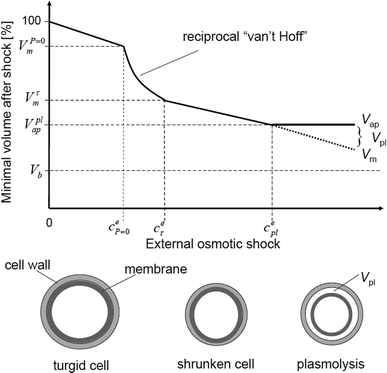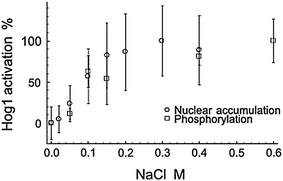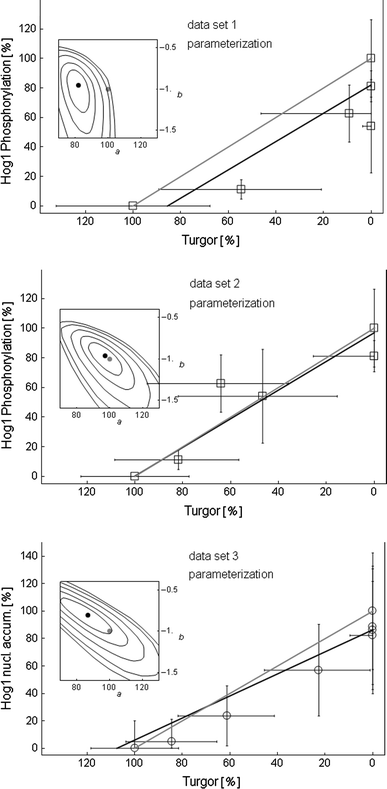Biophysical properties of Saccharomyces cerevisiae and their relationship with HOG pathway activation
- PMID: 20563574
- PMCID: PMC2943578
- DOI: 10.1007/s00249-010-0612-0
Biophysical properties of Saccharomyces cerevisiae and their relationship with HOG pathway activation
Abstract
Parameterized models of biophysical and mechanical cell properties are important for predictive mathematical modeling of cellular processes. The concepts of turgor, cell wall elasticity, osmotically active volume, and intracellular osmolarity have been investigated for decades, but a consistent rigorous parameterization of these concepts is lacking. Here, we subjected several data sets of minimum volume measurements in yeast obtained after hyper-osmotic shock to a thermodynamic modeling framework. We estimated parameters for several relevant biophysical cell properties and tested alternative hypotheses about these concepts using a model discrimination approach. In accordance with previous reports, we estimated an average initial turgor of 0.6 ± 0.2 MPa and found that turgor becomes negligible at a relative volume of 93.3 ± 6.3% corresponding to an osmotic shock of 0.4 ± 0.2 Osm/l. At high stress levels (4 Osm/l), plasmolysis may occur. We found that the volumetric elastic modulus, a measure of cell wall elasticity, is 14.3 ± 10.4 MPa. Our model discrimination analysis suggests that other thermodynamic quantities affecting the intracellular water potential, for example the matrix potential, can be neglected under physiological conditions. The parameterized turgor models showed that activation of the osmosensing high osmolarity glycerol (HOG) signaling pathway correlates with turgor loss in a 1:1 relationship. This finding suggests that mechanical properties of the membrane trigger HOG pathway activation, which can be represented and quantitatively modeled by turgor.
Figures





Similar articles
-
Systems Level Analysis of the Yeast Osmo-Stat.Sci Rep. 2016 Aug 12;6:30950. doi: 10.1038/srep30950. Sci Rep. 2016. PMID: 27515486 Free PMC article.
-
Stimulation of the yeast high osmolarity glycerol (HOG) pathway: evidence for a signal generated by a change in turgor rather than by water stress.FEBS Lett. 2000 Apr 21;472(1):159-65. doi: 10.1016/s0014-5793(00)01445-9. FEBS Lett. 2000. PMID: 10781825
-
Response to high osmotic conditions and elevated temperature in Saccharomyces cerevisiae is controlled by intracellular glycerol and involves coordinate activity of MAP kinase pathways.Microbiology (Reading). 2003 May;149(Pt 5):1193-1204. doi: 10.1099/mic.0.26110-0. Microbiology (Reading). 2003. PMID: 12724381
-
Yeast osmoregulation.Methods Enzymol. 2007;428:29-45. doi: 10.1016/S0076-6879(07)28002-4. Methods Enzymol. 2007. PMID: 17875410 Review.
-
Osmoregulation in Saccharomyces cerevisiae via mechanisms other than the high-osmolarity glycerol pathway.Microbiology (Reading). 2016 Sep;162(9):1511-1526. doi: 10.1099/mic.0.000360. Epub 2016 Aug 23. Microbiology (Reading). 2016. PMID: 27557593 Review.
Cited by
-
Penetrating the ultra-tough yeast cell wall with finite element analysis model-aided design of microtools.iScience. 2024 Mar 16;27(4):109503. doi: 10.1016/j.isci.2024.109503. eCollection 2024 Apr 19. iScience. 2024. PMID: 38591007 Free PMC article.
-
Host carbon sources modulate cell wall architecture, drug resistance and virulence in a fungal pathogen.Cell Microbiol. 2012 Sep;14(9):1319-35. doi: 10.1111/j.1462-5822.2012.01813.x. Epub 2012 Jun 5. Cell Microbiol. 2012. PMID: 22587014 Free PMC article.
-
Severe osmotic compression triggers a slowdown of intracellular signaling, which can be explained by molecular crowding.Proc Natl Acad Sci U S A. 2013 Apr 2;110(14):5725-30. doi: 10.1073/pnas.1215367110. Epub 2013 Mar 14. Proc Natl Acad Sci U S A. 2013. PMID: 23493557 Free PMC article.
-
Systems Level Analysis of the Yeast Osmo-Stat.Sci Rep. 2016 Aug 12;6:30950. doi: 10.1038/srep30950. Sci Rep. 2016. PMID: 27515486 Free PMC article.
-
Osmolyte homeostasis controls single-cell growth rate and maximum cell size of Saccharomyces cerevisiae.NPJ Syst Biol Appl. 2019 Sep 26;5:34. doi: 10.1038/s41540-019-0111-6. eCollection 2019. NPJ Syst Biol Appl. 2019. PMID: 31583116 Free PMC article.
References
-
- Burnham KP, Anderson DR. Model selection and multi-model inference: a practical information-theoretic approach. Berlin: Springer; 2002.
-
- Burström HG. Wishful thinking of turgor. Nature. 1971;234:488. doi: 10.1038/234488a0. - DOI
Publication types
MeSH terms
Substances
LinkOut - more resources
Full Text Sources
Molecular Biology Databases

